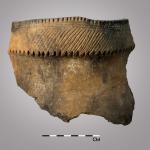Unearthing Ceramic Technology and Pottery Traditions at the Mohawk Garoga Site

The Haudenosaunee (meaning “People of the Longhouse” or Iroquois) are famous for their pottery. In the 16th century, they produced thin walled, finely tempered pots of various sizes with well-defined collars decorated with incised geometric patterns. In every village, the Haudenosaunee used pots for cooking and storage, and skilled potters routinely produced pots of exceptional quality. Archaeological excavations at these ancient villages have recovered thousands of pottery sherd fragments.
One such example of a Haudenosaunee village is Garoga, a Kanien’keha:ka (meaning “People of the Flint” or Mohawk) village site situated on a steep-sided hilltop in Fulton County, and radiocarbon dated to circa 1550-1582 A.D. Excavations by the New York State Museum (NYSM) in the 1960s revealed a palisaded village with 13 longhouses and recovered thousands of pottery sherds and unexpectedly, 43 raw, unfired clay nodules that were likely intended for use in creating pottery. While pottery from the Garoga site has been described, these clay nodules have received little attention. In a recent re-examination of the Garoga site collection, we realized that complementary study of both the pottery sherds and clay nodules could lead to new insights into ancient pottery manufacture at Garoga and its roles in the lives of the Kanien’keha:ka (Mohawk) inhabitants.
This collaborative study will include geological and spatial analysis of the pottery and clay nodules from the site, coupled with replication of Garoga site pottery by award-winning Kanien’keha:ka (Mohawk) potter Natasha Smoke Santiago using clays harvested from the banks of Caroga Creek below the site (clay deposits that were likely used by the 16th-century site inhabitants).
For this research, we greatly appreciate the support of (1) the Archaeological Conservancy (www.thearchcons.org), owner of the Garoga site and its representative Ms. Kelley Berliner, and (2) the Charles Touhey Foundation. We look forward to sharing future insights stemming from this exciting collaboration!
Permission for this research has been granted by the Saint Regis Mohawk Tribal Preservation Office and Mr. Darren Bonaparte, Tribal Historic Preservation Officer (www.srmt-nsn.gov).


